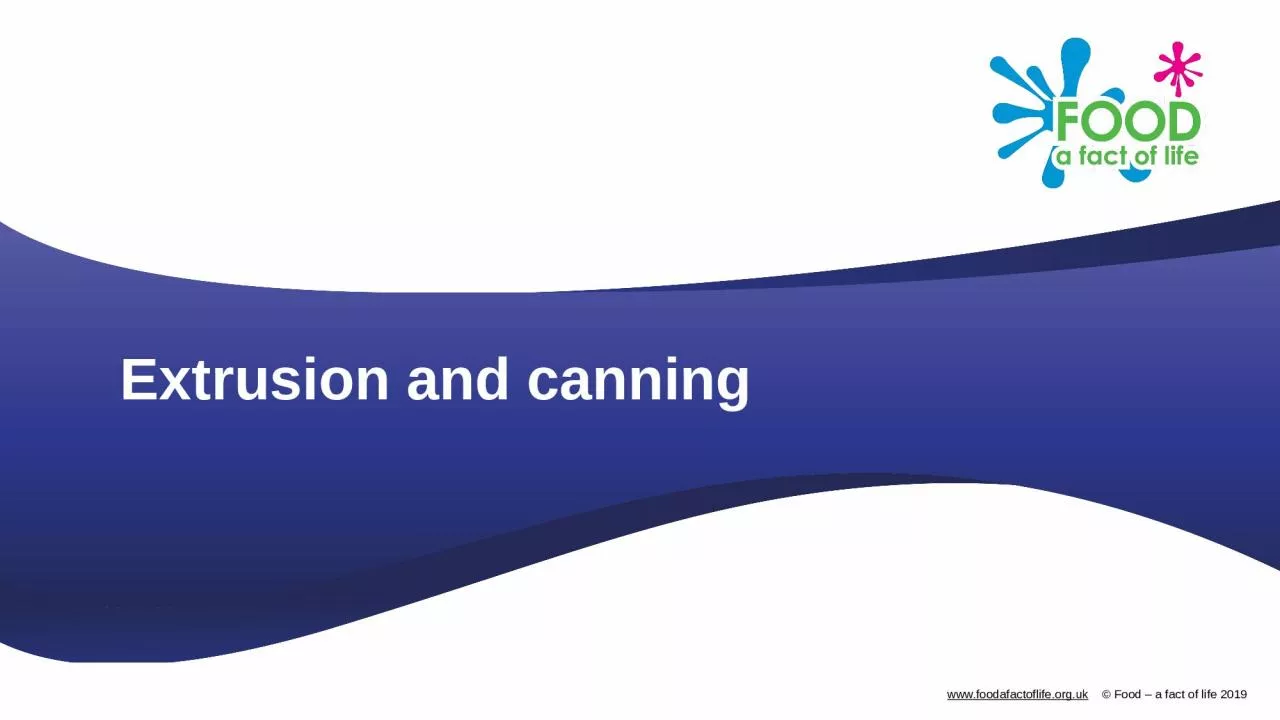

Extrusion is a process where raw materials are forced through a cylindrical barrel in order to form shape and sometimes cook The principle behind industrial extrusion is similar to that of a domestic meat mincer however on a much larger scale ID: 1022316
Download Presentation The PPT/PDF document "Extrusion and canning Extrusion" is the property of its rightful owner. Permission is granted to download and print the materials on this web site for personal, non-commercial use only, and to display it on your personal computer provided you do not modify the materials and that you retain all copyright notices contained in the materials. By downloading content from our website, you accept the terms of this agreement.
1. Extrusion and canning
2. Extrusion Extrusion is a process where raw materials are forced through a cylindrical barrel in order to form, shape and sometimes cook.The principle behind industrial extrusion is similar to that of a domestic meat mincer, however on a much larger scale.
3. Domestic meat mincerMeat is put into the top.The handle is turned in order to rotate the screw running through the barrel.The meat is forced through the barrel, breaking its structure.The meat emerges through a die and is formed into mincemeat. Industrial extrusionRaw ingredients are placed into the hopper.The screw is rotated, forcing materials along the barrel.Heat may be applied or removed, depending on the product.Product emerges through a die.Domestic compared to industrial
4. Extrusion in the food industryExtrusion is used within industry as it can:work continuously;act as a heat exchanger (i.e. heat or cool);handle viscous materials (i.e. thick mixtures);produce a range of different products (textures and shapes).
5. Uses of extrusion in industry - PastaPasta production relies mainly on the process of extrusion, e.g. macaroni and spaghetti. Low temperatures and pressure are needed to keep the pasta from cooking.
6. Uses of extrusion in industry - SnacksThe production of snack products is a rapidly growing area. High temperatures and pressures are necessary to produce the snacks. Due to changes in pressure, as well as water being removed due to heat, these products often ‘puff up’ or expand.
7. CanningCanning aims to destroy all micro-organisms and their spores through the application of heat. This is achieved by sterilising the food within air-tight containers to prevent re-contamination.
8. Domestic compared to industrialThe stages of canning are:cleaning of raw materials;size reduction;blanching;filling;sealing;washing;sterilisation;cooling;drying;labelling.
9. Cleaning of raw materialsAll food to be canned must be washed thoroughly to remove contaminants and inedible matter. For some products this is a one-step process. For others, such as stews, all separate ingredients must go through this process.Size reductionCertain ingredients, such as vegetables, need to be sliced or diced in order to fit into cans. However, some varieties of carrot are grown especially so that they fit into the can whole.
10. BlanchingProducts which contain fruit and vegetables need these ingredients blanched (i.e. briefly immersed in boiling water) before they can be packaged. This process helps with filling the can. Blanching must take place quickly, to prevent any enzymic reactions from occurring, such as discolouration .
11. FillingThe cans are filled automatically with a measured weight or volume of product. A solution of brine, savoury sauce, fruit juice or sugar syrup is usually added. A space is left at the top or the can will distort when sterilised. Food is also packaged in plastic containers. These are known as plastic cans (e.g. ambient ready meals).
12. SealingThe cans are sealed, under vacuum, using a double seam on the can rim. A vacuum is applied to draw out the air at the top of the can and seal the lid. At this stage some product may seep out.WashingOnce sealed, cans are washed to remove any external particles, and are then ready to be sterilised.
13. SterilisationBatches of cans are placed in a retort, which works like a large pressure cooker. The time taken to sterilise the contents at boiling point would be relatively long. By canning under pressure less time is needed as the temperature rises to 121ºC.The retort is sealed and steam is injected. This causes the temperature to rise and eventually results in air being driven out of the retort.
14. SterilisationThe type of product being canned is of importance at this stage. ‘Solid pack’ contents, e.g. canned meat, need more time as the heat needs to penetrate the product by conduction. However ‘liquid pack’ contents, e.g. soups, need far less time as the liquid present helps transfer the heat by convection. This will dictate the pressure and time needed to sterilise the product throughout.
15. CoolingAfter the cans have been sterilised, they are cooled to prevent overcooking of the contents. This is achieved by spraying cool water over the cans and a gentle reduction in pressure. Any sudden drop in temperature would cause the cans to distort and damage the can seams. While still warm, the cans are removed and passed through a cooling tank to reduce the temperature further.
16. Drying The remaining heat from the can evaporates any water left on the surface. This is important to prevent rusting during storage and the risk of intake of dirty water if there is a seam defect.LabellingFinally, cans are coded then labelled with a ‘best before’ date.
17. Extrusion and canning For further information, go to:www.foodafactoflife.org.uk